Australian Banking Sector: An Analysis of Oligopolistic Competition
VerifiedAdded on 2020/02/24
|5
|1412
|36
Report
AI Summary
This report examines the oligopolistic competition within the Australian banking sector, focusing on the dominance of the "big four" banks and their impact on the broader economy. The analysis draws upon a Financial Review article and other sources to highlight the Treasurer's criticisms, the banks' market power, and the government's proposed bank levy. It explores the lack of competition, transparency issues, and the resulting systemic risks. Recommendations include monitoring the potential for banks to pass tax costs to customers, and addressing the perceived advantage of the major banks in times of crisis. The report concludes that despite government interventions, stakeholders must collaborate to ensure fair competition and restore confidence in the financial sector. The report emphasizes the need for reforms to be fully implemented and for further measures to be taken to promote fair competition and transparency. It suggests that the government should also focus on other sectors of the economy that are not competitive enough, such as the energy sector.
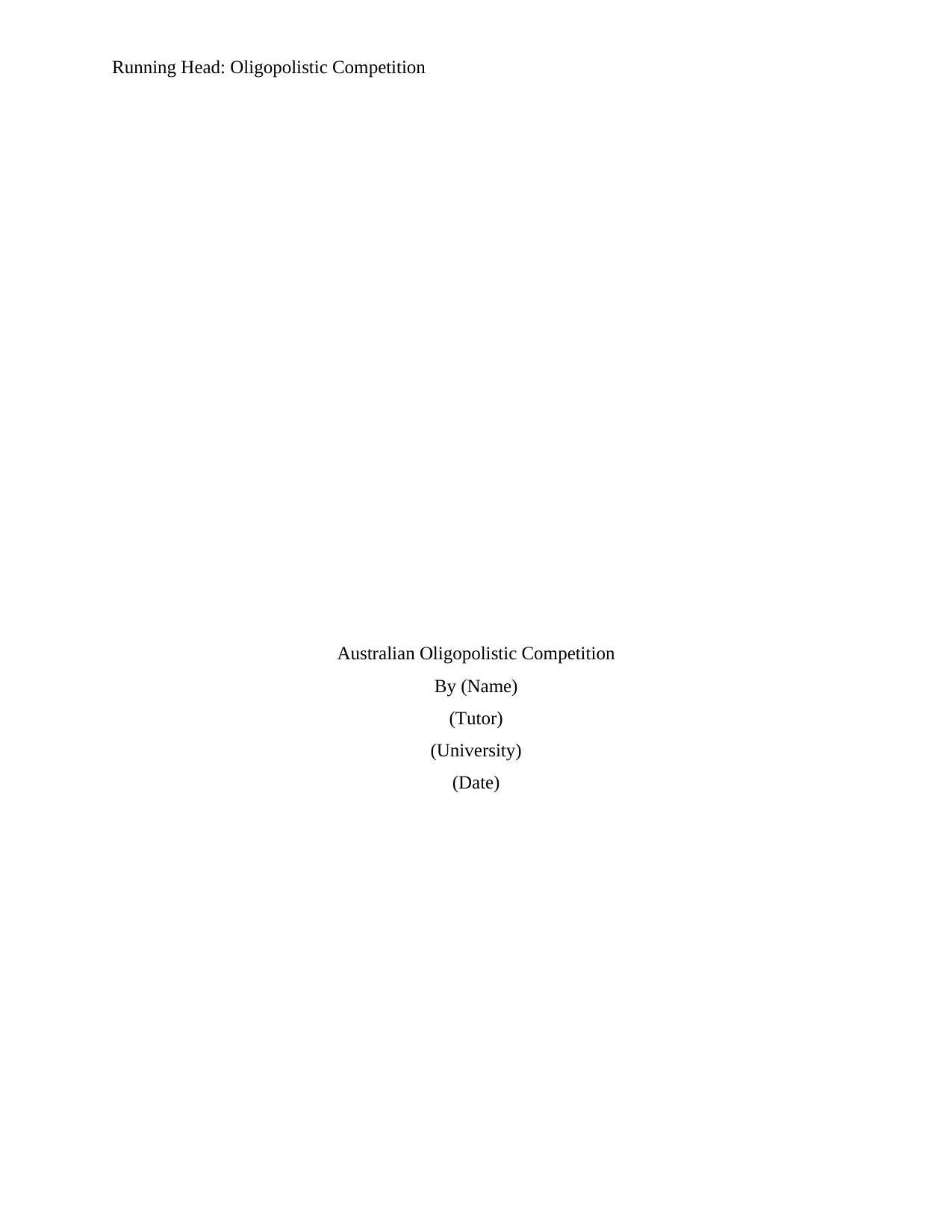
Running Head: Oligopolistic Competition
Australian Oligopolistic Competition
By (Name)
(Tutor)
(University)
(Date)
Australian Oligopolistic Competition
By (Name)
(Tutor)
(University)
(Date)
Paraphrase This Document
Need a fresh take? Get an instant paraphrase of this document with our AI Paraphraser
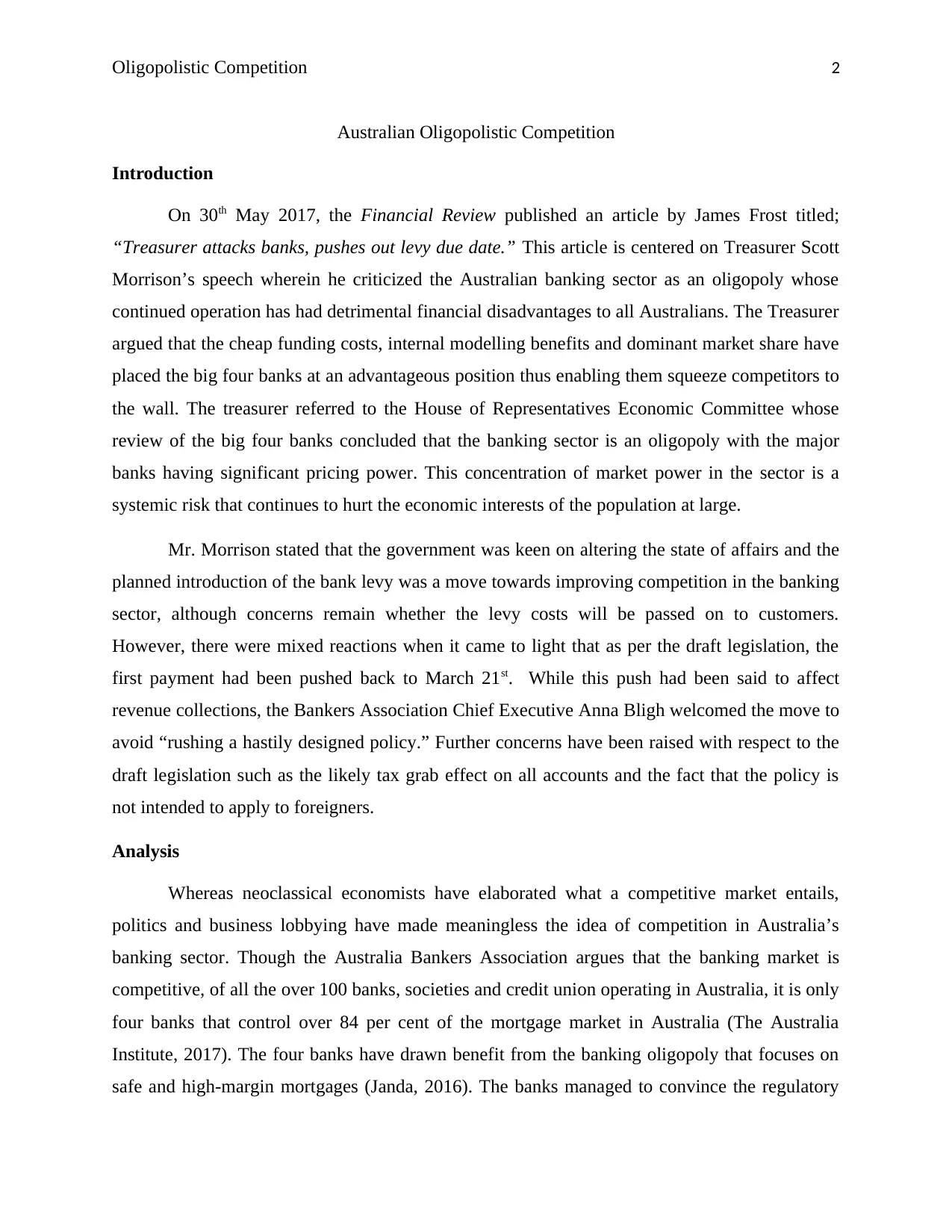
Oligopolistic Competition 2
Australian Oligopolistic Competition
Introduction
On 30th May 2017, the Financial Review published an article by James Frost titled;
“Treasurer attacks banks, pushes out levy due date.” This article is centered on Treasurer Scott
Morrison’s speech wherein he criticized the Australian banking sector as an oligopoly whose
continued operation has had detrimental financial disadvantages to all Australians. The Treasurer
argued that the cheap funding costs, internal modelling benefits and dominant market share have
placed the big four banks at an advantageous position thus enabling them squeeze competitors to
the wall. The treasurer referred to the House of Representatives Economic Committee whose
review of the big four banks concluded that the banking sector is an oligopoly with the major
banks having significant pricing power. This concentration of market power in the sector is a
systemic risk that continues to hurt the economic interests of the population at large.
Mr. Morrison stated that the government was keen on altering the state of affairs and the
planned introduction of the bank levy was a move towards improving competition in the banking
sector, although concerns remain whether the levy costs will be passed on to customers.
However, there were mixed reactions when it came to light that as per the draft legislation, the
first payment had been pushed back to March 21st. While this push had been said to affect
revenue collections, the Bankers Association Chief Executive Anna Bligh welcomed the move to
avoid “rushing a hastily designed policy.” Further concerns have been raised with respect to the
draft legislation such as the likely tax grab effect on all accounts and the fact that the policy is
not intended to apply to foreigners.
Analysis
Whereas neoclassical economists have elaborated what a competitive market entails,
politics and business lobbying have made meaningless the idea of competition in Australia’s
banking sector. Though the Australia Bankers Association argues that the banking market is
competitive, of all the over 100 banks, societies and credit union operating in Australia, it is only
four banks that control over 84 per cent of the mortgage market in Australia (The Australia
Institute, 2017). The four banks have drawn benefit from the banking oligopoly that focuses on
safe and high-margin mortgages (Janda, 2016). The banks managed to convince the regulatory
Australian Oligopolistic Competition
Introduction
On 30th May 2017, the Financial Review published an article by James Frost titled;
“Treasurer attacks banks, pushes out levy due date.” This article is centered on Treasurer Scott
Morrison’s speech wherein he criticized the Australian banking sector as an oligopoly whose
continued operation has had detrimental financial disadvantages to all Australians. The Treasurer
argued that the cheap funding costs, internal modelling benefits and dominant market share have
placed the big four banks at an advantageous position thus enabling them squeeze competitors to
the wall. The treasurer referred to the House of Representatives Economic Committee whose
review of the big four banks concluded that the banking sector is an oligopoly with the major
banks having significant pricing power. This concentration of market power in the sector is a
systemic risk that continues to hurt the economic interests of the population at large.
Mr. Morrison stated that the government was keen on altering the state of affairs and the
planned introduction of the bank levy was a move towards improving competition in the banking
sector, although concerns remain whether the levy costs will be passed on to customers.
However, there were mixed reactions when it came to light that as per the draft legislation, the
first payment had been pushed back to March 21st. While this push had been said to affect
revenue collections, the Bankers Association Chief Executive Anna Bligh welcomed the move to
avoid “rushing a hastily designed policy.” Further concerns have been raised with respect to the
draft legislation such as the likely tax grab effect on all accounts and the fact that the policy is
not intended to apply to foreigners.
Analysis
Whereas neoclassical economists have elaborated what a competitive market entails,
politics and business lobbying have made meaningless the idea of competition in Australia’s
banking sector. Though the Australia Bankers Association argues that the banking market is
competitive, of all the over 100 banks, societies and credit union operating in Australia, it is only
four banks that control over 84 per cent of the mortgage market in Australia (The Australia
Institute, 2017). The four banks have drawn benefit from the banking oligopoly that focuses on
safe and high-margin mortgages (Janda, 2016). The banks managed to convince the regulatory
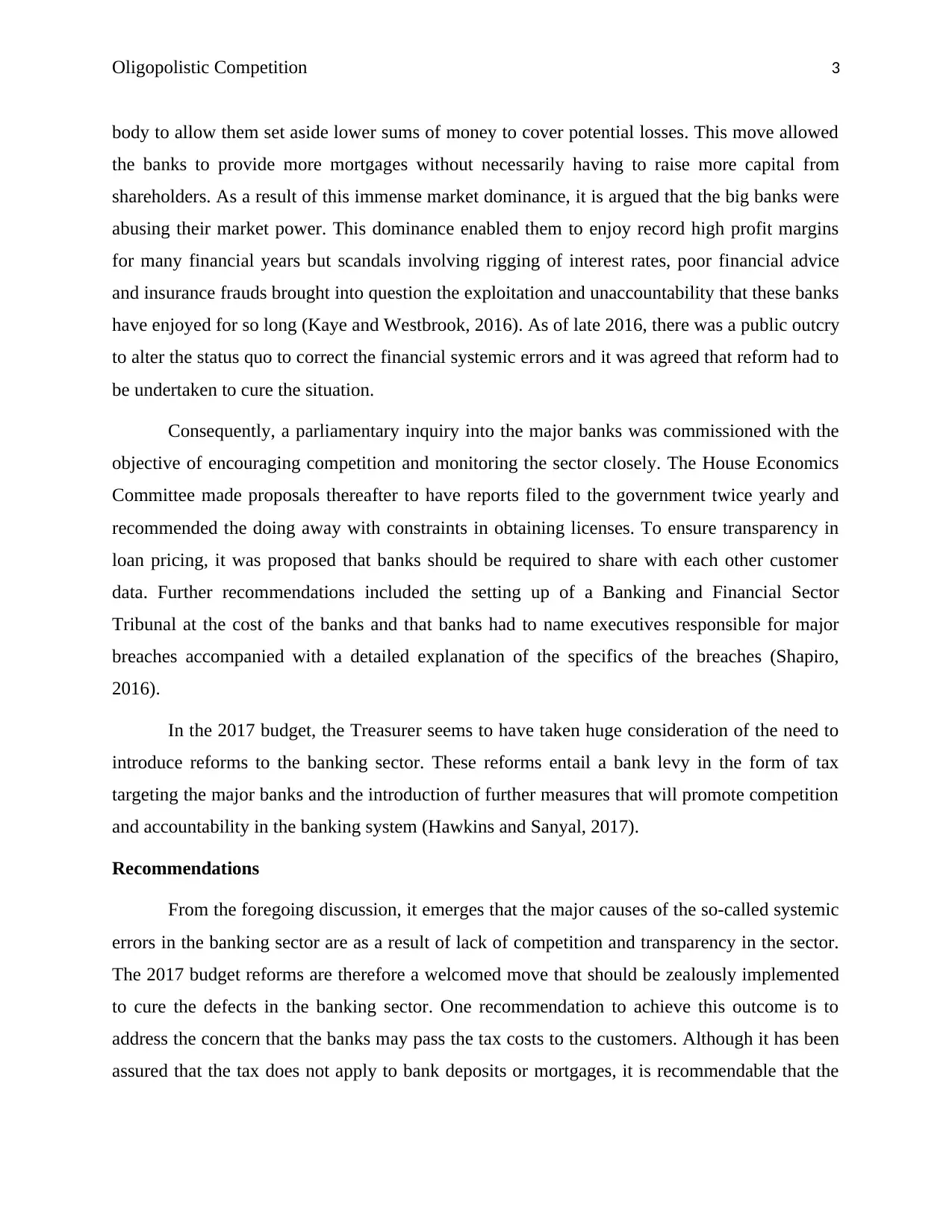
Oligopolistic Competition 3
body to allow them set aside lower sums of money to cover potential losses. This move allowed
the banks to provide more mortgages without necessarily having to raise more capital from
shareholders. As a result of this immense market dominance, it is argued that the big banks were
abusing their market power. This dominance enabled them to enjoy record high profit margins
for many financial years but scandals involving rigging of interest rates, poor financial advice
and insurance frauds brought into question the exploitation and unaccountability that these banks
have enjoyed for so long (Kaye and Westbrook, 2016). As of late 2016, there was a public outcry
to alter the status quo to correct the financial systemic errors and it was agreed that reform had to
be undertaken to cure the situation.
Consequently, a parliamentary inquiry into the major banks was commissioned with the
objective of encouraging competition and monitoring the sector closely. The House Economics
Committee made proposals thereafter to have reports filed to the government twice yearly and
recommended the doing away with constraints in obtaining licenses. To ensure transparency in
loan pricing, it was proposed that banks should be required to share with each other customer
data. Further recommendations included the setting up of a Banking and Financial Sector
Tribunal at the cost of the banks and that banks had to name executives responsible for major
breaches accompanied with a detailed explanation of the specifics of the breaches (Shapiro,
2016).
In the 2017 budget, the Treasurer seems to have taken huge consideration of the need to
introduce reforms to the banking sector. These reforms entail a bank levy in the form of tax
targeting the major banks and the introduction of further measures that will promote competition
and accountability in the banking system (Hawkins and Sanyal, 2017).
Recommendations
From the foregoing discussion, it emerges that the major causes of the so-called systemic
errors in the banking sector are as a result of lack of competition and transparency in the sector.
The 2017 budget reforms are therefore a welcomed move that should be zealously implemented
to cure the defects in the banking sector. One recommendation to achieve this outcome is to
address the concern that the banks may pass the tax costs to the customers. Although it has been
assured that the tax does not apply to bank deposits or mortgages, it is recommendable that the
body to allow them set aside lower sums of money to cover potential losses. This move allowed
the banks to provide more mortgages without necessarily having to raise more capital from
shareholders. As a result of this immense market dominance, it is argued that the big banks were
abusing their market power. This dominance enabled them to enjoy record high profit margins
for many financial years but scandals involving rigging of interest rates, poor financial advice
and insurance frauds brought into question the exploitation and unaccountability that these banks
have enjoyed for so long (Kaye and Westbrook, 2016). As of late 2016, there was a public outcry
to alter the status quo to correct the financial systemic errors and it was agreed that reform had to
be undertaken to cure the situation.
Consequently, a parliamentary inquiry into the major banks was commissioned with the
objective of encouraging competition and monitoring the sector closely. The House Economics
Committee made proposals thereafter to have reports filed to the government twice yearly and
recommended the doing away with constraints in obtaining licenses. To ensure transparency in
loan pricing, it was proposed that banks should be required to share with each other customer
data. Further recommendations included the setting up of a Banking and Financial Sector
Tribunal at the cost of the banks and that banks had to name executives responsible for major
breaches accompanied with a detailed explanation of the specifics of the breaches (Shapiro,
2016).
In the 2017 budget, the Treasurer seems to have taken huge consideration of the need to
introduce reforms to the banking sector. These reforms entail a bank levy in the form of tax
targeting the major banks and the introduction of further measures that will promote competition
and accountability in the banking system (Hawkins and Sanyal, 2017).
Recommendations
From the foregoing discussion, it emerges that the major causes of the so-called systemic
errors in the banking sector are as a result of lack of competition and transparency in the sector.
The 2017 budget reforms are therefore a welcomed move that should be zealously implemented
to cure the defects in the banking sector. One recommendation to achieve this outcome is to
address the concern that the banks may pass the tax costs to the customers. Although it has been
assured that the tax does not apply to bank deposits or mortgages, it is recommendable that the
⊘ This is a preview!⊘
Do you want full access?
Subscribe today to unlock all pages.

Trusted by 1+ million students worldwide
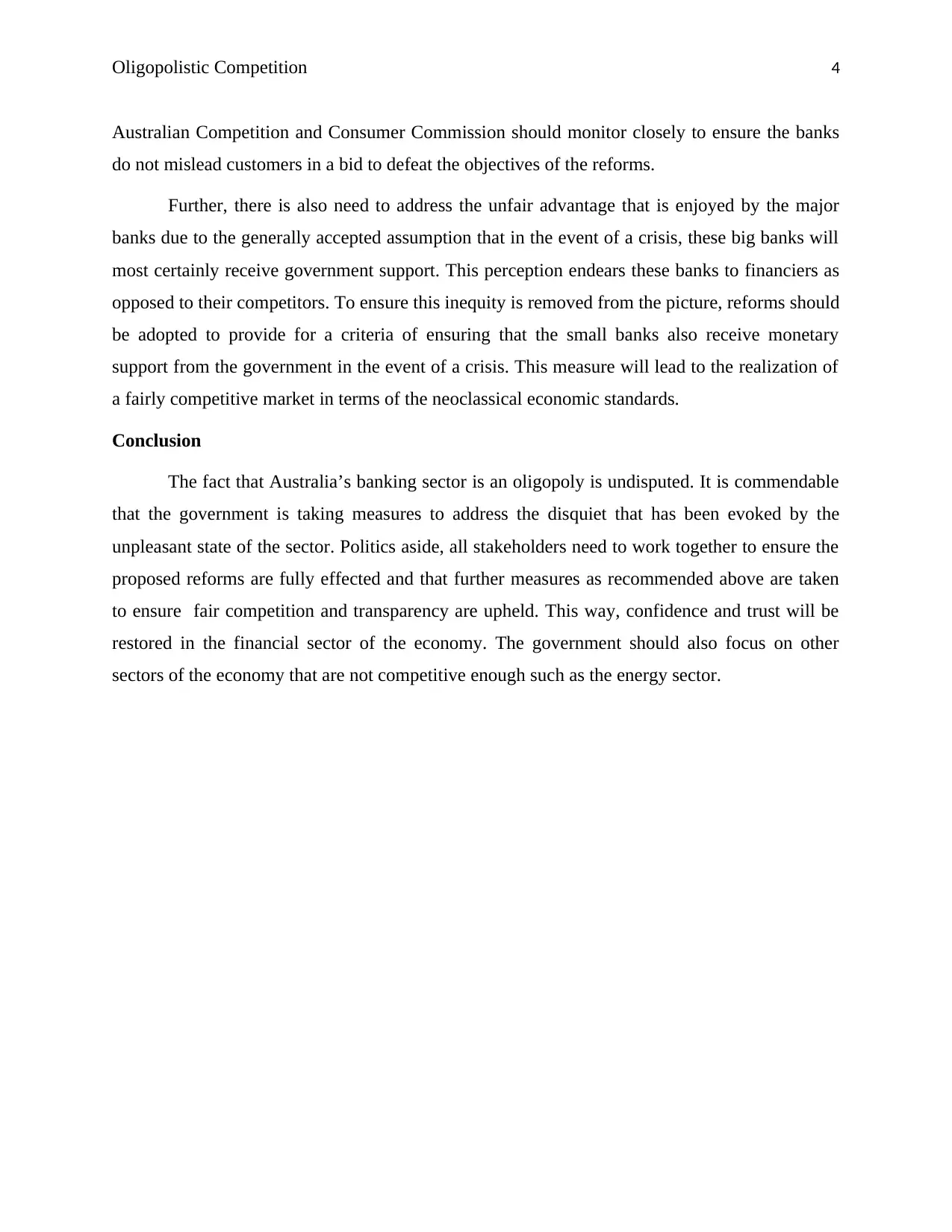
Oligopolistic Competition 4
Australian Competition and Consumer Commission should monitor closely to ensure the banks
do not mislead customers in a bid to defeat the objectives of the reforms.
Further, there is also need to address the unfair advantage that is enjoyed by the major
banks due to the generally accepted assumption that in the event of a crisis, these big banks will
most certainly receive government support. This perception endears these banks to financiers as
opposed to their competitors. To ensure this inequity is removed from the picture, reforms should
be adopted to provide for a criteria of ensuring that the small banks also receive monetary
support from the government in the event of a crisis. This measure will lead to the realization of
a fairly competitive market in terms of the neoclassical economic standards.
Conclusion
The fact that Australia’s banking sector is an oligopoly is undisputed. It is commendable
that the government is taking measures to address the disquiet that has been evoked by the
unpleasant state of the sector. Politics aside, all stakeholders need to work together to ensure the
proposed reforms are fully effected and that further measures as recommended above are taken
to ensure fair competition and transparency are upheld. This way, confidence and trust will be
restored in the financial sector of the economy. The government should also focus on other
sectors of the economy that are not competitive enough such as the energy sector.
Australian Competition and Consumer Commission should monitor closely to ensure the banks
do not mislead customers in a bid to defeat the objectives of the reforms.
Further, there is also need to address the unfair advantage that is enjoyed by the major
banks due to the generally accepted assumption that in the event of a crisis, these big banks will
most certainly receive government support. This perception endears these banks to financiers as
opposed to their competitors. To ensure this inequity is removed from the picture, reforms should
be adopted to provide for a criteria of ensuring that the small banks also receive monetary
support from the government in the event of a crisis. This measure will lead to the realization of
a fairly competitive market in terms of the neoclassical economic standards.
Conclusion
The fact that Australia’s banking sector is an oligopoly is undisputed. It is commendable
that the government is taking measures to address the disquiet that has been evoked by the
unpleasant state of the sector. Politics aside, all stakeholders need to work together to ensure the
proposed reforms are fully effected and that further measures as recommended above are taken
to ensure fair competition and transparency are upheld. This way, confidence and trust will be
restored in the financial sector of the economy. The government should also focus on other
sectors of the economy that are not competitive enough such as the energy sector.
Paraphrase This Document
Need a fresh take? Get an instant paraphrase of this document with our AI Paraphraser
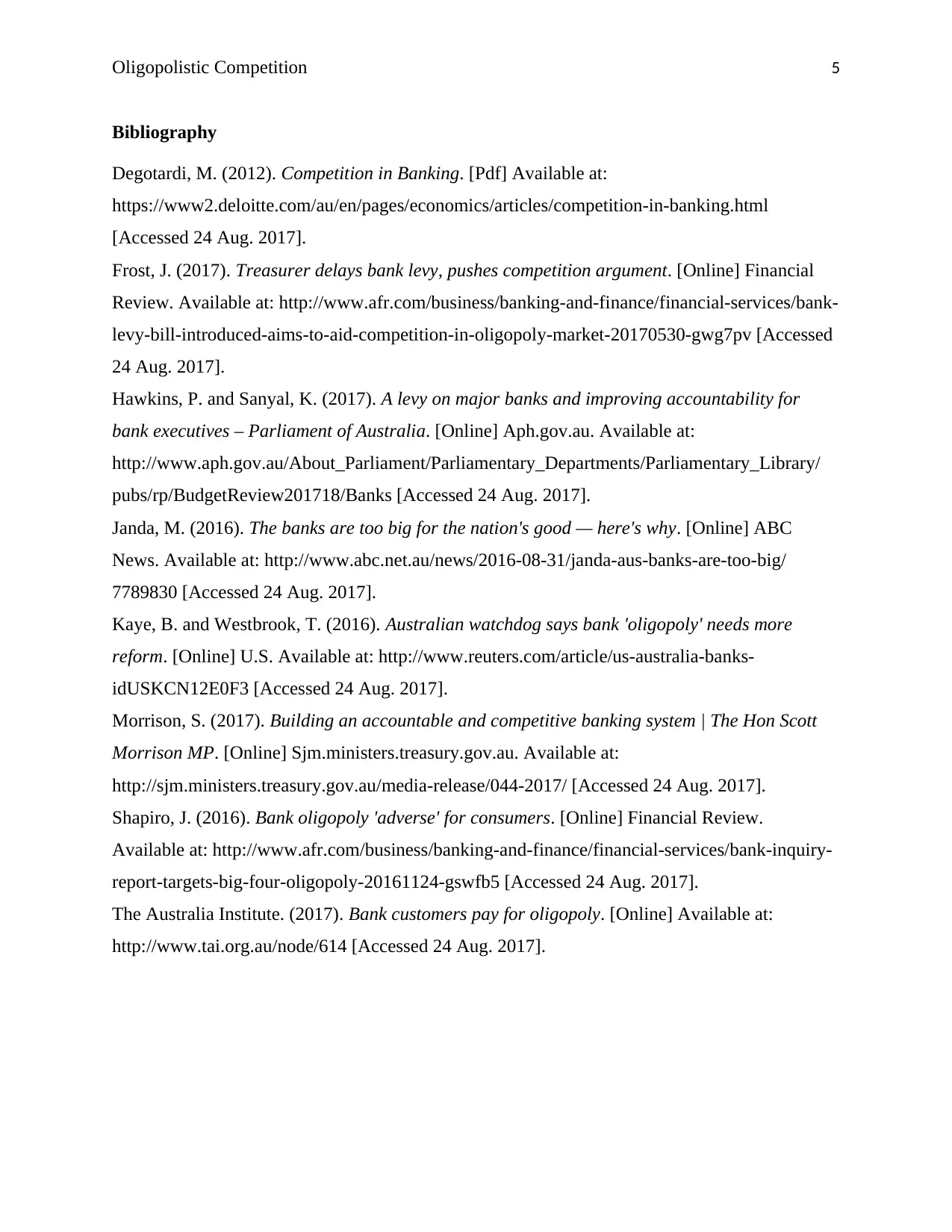
Oligopolistic Competition 5
Bibliography
Degotardi, M. (2012). Competition in Banking. [Pdf] Available at:
https://www2.deloitte.com/au/en/pages/economics/articles/competition-in-banking.html
[Accessed 24 Aug. 2017].
Frost, J. (2017). Treasurer delays bank levy, pushes competition argument. [Online] Financial
Review. Available at: http://www.afr.com/business/banking-and-finance/financial-services/bank-
levy-bill-introduced-aims-to-aid-competition-in-oligopoly-market-20170530-gwg7pv [Accessed
24 Aug. 2017].
Hawkins, P. and Sanyal, K. (2017). A levy on major banks and improving accountability for
bank executives – Parliament of Australia. [Online] Aph.gov.au. Available at:
http://www.aph.gov.au/About_Parliament/Parliamentary_Departments/Parliamentary_Library/
pubs/rp/BudgetReview201718/Banks [Accessed 24 Aug. 2017].
Janda, M. (2016). The banks are too big for the nation's good — here's why. [Online] ABC
News. Available at: http://www.abc.net.au/news/2016-08-31/janda-aus-banks-are-too-big/
7789830 [Accessed 24 Aug. 2017].
Kaye, B. and Westbrook, T. (2016). Australian watchdog says bank 'oligopoly' needs more
reform. [Online] U.S. Available at: http://www.reuters.com/article/us-australia-banks-
idUSKCN12E0F3 [Accessed 24 Aug. 2017].
Morrison, S. (2017). Building an accountable and competitive banking system | The Hon Scott
Morrison MP. [Online] Sjm.ministers.treasury.gov.au. Available at:
http://sjm.ministers.treasury.gov.au/media-release/044-2017/ [Accessed 24 Aug. 2017].
Shapiro, J. (2016). Bank oligopoly 'adverse' for consumers. [Online] Financial Review.
Available at: http://www.afr.com/business/banking-and-finance/financial-services/bank-inquiry-
report-targets-big-four-oligopoly-20161124-gswfb5 [Accessed 24 Aug. 2017].
The Australia Institute. (2017). Bank customers pay for oligopoly. [Online] Available at:
http://www.tai.org.au/node/614 [Accessed 24 Aug. 2017].
Bibliography
Degotardi, M. (2012). Competition in Banking. [Pdf] Available at:
https://www2.deloitte.com/au/en/pages/economics/articles/competition-in-banking.html
[Accessed 24 Aug. 2017].
Frost, J. (2017). Treasurer delays bank levy, pushes competition argument. [Online] Financial
Review. Available at: http://www.afr.com/business/banking-and-finance/financial-services/bank-
levy-bill-introduced-aims-to-aid-competition-in-oligopoly-market-20170530-gwg7pv [Accessed
24 Aug. 2017].
Hawkins, P. and Sanyal, K. (2017). A levy on major banks and improving accountability for
bank executives – Parliament of Australia. [Online] Aph.gov.au. Available at:
http://www.aph.gov.au/About_Parliament/Parliamentary_Departments/Parliamentary_Library/
pubs/rp/BudgetReview201718/Banks [Accessed 24 Aug. 2017].
Janda, M. (2016). The banks are too big for the nation's good — here's why. [Online] ABC
News. Available at: http://www.abc.net.au/news/2016-08-31/janda-aus-banks-are-too-big/
7789830 [Accessed 24 Aug. 2017].
Kaye, B. and Westbrook, T. (2016). Australian watchdog says bank 'oligopoly' needs more
reform. [Online] U.S. Available at: http://www.reuters.com/article/us-australia-banks-
idUSKCN12E0F3 [Accessed 24 Aug. 2017].
Morrison, S. (2017). Building an accountable and competitive banking system | The Hon Scott
Morrison MP. [Online] Sjm.ministers.treasury.gov.au. Available at:
http://sjm.ministers.treasury.gov.au/media-release/044-2017/ [Accessed 24 Aug. 2017].
Shapiro, J. (2016). Bank oligopoly 'adverse' for consumers. [Online] Financial Review.
Available at: http://www.afr.com/business/banking-and-finance/financial-services/bank-inquiry-
report-targets-big-four-oligopoly-20161124-gswfb5 [Accessed 24 Aug. 2017].
The Australia Institute. (2017). Bank customers pay for oligopoly. [Online] Available at:
http://www.tai.org.au/node/614 [Accessed 24 Aug. 2017].
1 out of 5
Related Documents
Your All-in-One AI-Powered Toolkit for Academic Success.
+13062052269
info@desklib.com
Available 24*7 on WhatsApp / Email
![[object Object]](/_next/static/media/star-bottom.7253800d.svg)
Unlock your academic potential
Copyright © 2020–2025 A2Z Services. All Rights Reserved. Developed and managed by ZUCOL.





